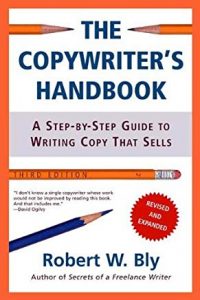The Copywriter’s Handbook: A Step-by-Step Guide to Writing Copy that Sells, Robert W. Bly / A Book Review
Bly Writes to Sell, Part 1
Robert W. Bly. 2005. The Copywriter’s Handbook: A Step-by-Step Guide to Writing Copy that Sells. New York: St. Martin’s Griffin.
At the heart of the Gospel is a tough sell: give up your sinful desires and surrender your life to God. In my work at T2Pneuma Publishers LLC, I summarize the Gospel with this catch phrase: Hear the words; Follow the steps; Experience the joy! Only the Holy Spirit can close the deal, but the pitch must be made. The trouble is that most Christians, myself included, are terrible at sales.
In his book, The Copywriter’s Handbook, Robert W. Bly sets out with a clear objective:
“This book is written to give you guidelines and advice that can teach you to write effective copy—that is, copy that gets attention, gets its message across, and convinces the customer to buy the product.” (xv)
He defines copywriters as “salespeople whose job is to convince people to buy products” (xvi) and should not be confused with the process of registering a copyright for a book with the Library of Congress.
For those you who associate copywriting with those catchy ads placed during the Super Bowl, Bly’s focus on ads that communicate and sell may come as a surprise. But ask yourself a simple question, do you remember what products those Super Bowl ads were intending to sell? If not, then the ads may have caught your attention, but for the wrong reasons. Because advertising is expensive, it is important to focus on the informational and sales objectives in creating an ad.
Christians may get squeamish at this point and respond, as I have, that they are not salespeople. Maybe. But why does Charlie Brown feel compelled to ask: “What is the true meaning of Christmas?” If the message is unclear; it will not be heard. Because with the Gospel the stakes are high, we need to communicate clearly.
Bly is a professional copywriter who specializes in B2B, high tech, and direct-response advertising and is a prolific author.[1] Outside of front matter and numerous appendices, he writes in fifteen chapters:
- An Introduction to Copywriting
- Writing to Get Attention: The Headline
- Writing to Communicate
- Writing to Sell
- Getting Ready to Write
- Writing Print Advertisements
- Writing Direct Mail
- Writing Brochures, Catalogs, and Other Sales Materials
- Writing Public Relations Materials
- Writing Commercials and Multimedia Presentations
- Writing for the Web
- Writing E-Mail Marketing
- How to Get a Job as a Copywriter
- How to Hire and Work with Copywriters
- Graphic Design for Copywriters (xii)
While I started out thinking that I only really had an interest in the first couple chapters here, as I read on I discovered that Bly addressed a much wider set of my business writing activities than I had envisioned. Other than the chapters on working as and hiring copywriters, each of the chapters offered helpful advice on diverse aspects of my publishing business—much more than any of the numerous writing books that I have read—from issuing press releases to writing a newsletter.
For example, Bly reports that copywriters write two types of emails: the “solo email” and the “e-zine” The solo email is written to a distribution list promoting a single product (think direct marketing campaign, the online equivalent of junk mail) while the e-zine is an online newsletter (286). While this distinction may seem obvious, most independent writers focus exclusively on their personal newsletter, while a business-driven minority use product giveaways to launch automated email promotion campaigns. Bly is the first author that I have read who discusses the quality points of both alternatives.
In part one of this review, I have given an overview of Robert W. Bly’s The Copywriter’s Handbook. Part II of this review can be found at https://t2pneuma.net/2018/04/10/bly-writes-sell-part-2/
[1] B2B is short for business to business. www.Bly.com

Review by Stephen W. Hiemstra






